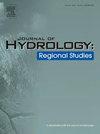Streamflow dynamics of Amazonian rivers according to their hydrogeochemical heterogeneity
IF 4.7
2区 地球科学
Q1 WATER RESOURCES
引用次数: 0
Abstract
Study Region
Amazon and Tocantins-Araguaia watersheds.
Study Focus
Watershed’s climatology and physiography are key drivers of hydrological processes, sediment yield, and river geochemistry. In the Amazon, rivers are traditionally classified into three hydrogeochemical types (whitewater, blackwater, and clearwater) based on their physicochemical characteristics. While this classification is well established, its relationship with streamflow dynamics remains largely unexplored. This study investigates whether distinct water discharge patterns exist among these river water types, offering insights into their environmental drivers. Specific streamflows and hydrological indexes derived from flow duration curves (1990–2019) of 106 river gauge stations distributed across the Brazilian Amazon were analyzed to characterize streamflow regimes.
New Hydrological Insights for the Region
Monitored blackwater rivers have the highest runoff generation per unit area, while clearwater rivers have the lowest. The relative intensity of peak flow increment is the largest in monitored whitewater and clearwater rivers and the smallest in blackwater rivers. The proportion of baseflow contribution to streamflow is the largest in monitored clearwater rivers and the smallest in whitewater rivers. Precipitation is a strong driver of streamflow regimes, but physiographic factors, such as land cover and geology, also play an important role, particularly in baseflow and peak flow. Understanding these hydrological differences is crucial for assessing ecological flow requirements, ultimately aiding sustainable water resource management, and the relationships between river geochemistry and streamflow in the Amazon.
基于水文地球化学非均质性的亚马逊河水流动力学
研究地区亚马逊和托坎廷-阿拉瓜流域。流域的气候和地貌是水文过程、产沙量和河流地球化学的关键驱动因素。在亚马逊河,河流通常根据其物理化学特征分为三种水文地球化学类型(白水、黑水和清水)。虽然这种分类很好地建立了,但它与水流动力学的关系在很大程度上仍未被探索。本研究调查了这些河流类型之间是否存在不同的水排放模式,为其环境驱动因素提供了见解。分析了分布在巴西亚马逊地区的106个河流监测站的流量持续时间曲线(1990-2019)的具体流量和水文指标,以表征河流的流动状态。受监测的黑水河流单位面积的径流量最高,而清水河流的径流量最低。白水和清水河流的峰值流量增量相对强度最大,黑水河流最小。基流对径流的贡献比例在监测的清水河中最大,在白水河中最小。降水是水流状态的一个强大驱动因素,但地理因素,如土地覆盖和地质,也起着重要作用,特别是在基流和峰流中。了解这些水文差异对于评估生态流量需求至关重要,最终有助于可持续水资源管理,以及河流地球化学与亚马逊河流量之间的关系。
本文章由计算机程序翻译,如有差异,请以英文原文为准。
求助全文
约1分钟内获得全文
求助全文
来源期刊

Journal of Hydrology-Regional Studies
Earth and Planetary Sciences-Earth and Planetary Sciences (miscellaneous)
CiteScore
6.70
自引率
8.50%
发文量
284
审稿时长
60 days
期刊介绍:
Journal of Hydrology: Regional Studies publishes original research papers enhancing the science of hydrology and aiming at region-specific problems, past and future conditions, analysis, review and solutions. The journal particularly welcomes research papers that deliver new insights into region-specific hydrological processes and responses to changing conditions, as well as contributions that incorporate interdisciplinarity and translational science.
 求助内容:
求助内容: 应助结果提醒方式:
应助结果提醒方式:


